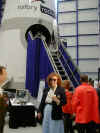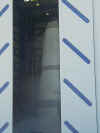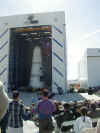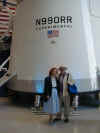
ROTARY ROCKET ROLLOUT
Wednesday, August 23, 2006
Sections
Alt.Mail
Special Reports
March first, 1999. Much of the rollout is available on the Rotary site, including most of the speeches. See ( www.rotaryrocket.com ). This was a very windy day in Mojave, which is to say, fairly typical. I would put the wind at about 25 knots, but it's been a while since I was a sailor. There wasn't a lot of dust: in Mojave the dust got blown away long ago. Rocks and gravel, yes, but not dust.
The pictures below are THUMBNAILS; click on the picture to get the large image.
Here are some pictures and impressions of my rollout experience:
Before the rollout, looking up into the cockpit area. That's Roberta who finally found some coffee.
Tom Clancy. That's Eric Laursen, a member of my Council, to the left. Eric is involved with sales of Proton Rockets from the USSR now, but he was part of the group that helped bring down the USSR in the first place...
Gary Hudson, Chairman and chief guru of Rotary Rocket and the guy who actually made it happen, looking justifiably pleased with the enormous turnout. They expected 600. They got 2,000 and more wanted to come. Private space is interesting.
That's me and Roberta, with some nice clouds in the background.
Mike Flynn, coauthor with me and Larry Niven of FALLEN ANGELS. Flynn is a quality control expert and the best practical statistician I ever met.
Dr. Phil Chapman, onetime Australian South Polar Explorer back in the days when they had dog teams in Antarctica (he has the funniest story of how he learned to sort out and hitch up dogs I ever heard, but it was life and death at the time, and he'd never done it before...). He's also a jet pilot, and onetime American Astronaut (having immigrated and got citizenship here). Phil is former President of the L5 Society, a member of my Council, and at present the Chief Scientist for Rotary Rocket.
Proteus, an airplane you may have heard of. That's the Mojave Airport tower behind it. This is looking 180 degrees away from the shed where they'll roll out the Rotary Roton...
Looking at the high bay doors. They're going to make speeched. They're going to make lots of speeches. In 30 knots of wind they will make speeches. While we are out here on bleachers in the wind they will make speeches. And more speeches. And then some more speeches.
Looking across the second bleacher of people toward the low bay hangar, Rotary's second building. Niven is over in there somewhere.
Aleta Jackson, onetime Executive Secretary of the L5 Society, onetime Editor of General Graham's High frontier publications and the Journal of Practical Applications of Space, and now sort of chief cook and bottle washer for Rotary. I don't know her title, but I do know that anything she's involved with runs well.
Here it comes. Understand, this thing is big, although small compared to the disintegrating totem poles that are normally used for space access.
Coming out...
Wide angle shot, to give some perspective. That's the low bay hangar on the right.
And another.
It's pretty. Note the helicopter blades on the top. When this flies, those, propelled by tip rocket motors, will be what fly it, until the rocket engines get put in on the bottom. Those aren't built yet. This is the atmospheric flight test vehicle. The next step is a re-entry grade aeroshell (this one wouldn't take re-entry) and full rotary rocket engines in the bottom. Then it will be a space ship. Incidentally this one could yet be part of a Zero Stage system if it comes to that. It's an expensive but useful helicopter. Odd helicopter, but a chopper none the less.
Tom Clancy again. In his speech he called me the "giant of science fiction" who introduced him to Gary Hudson. All of which I must say didn't make me too unhappy...
Gary Hudson with his parents. Quite proud of him they were. With reason.
I got Ann Hudson to stand in with Gary and his parents. Annie has been with Gary for a LONG time. Back at the Padres Island stand in 1980 one of her jobs was to feed the alligator so it wouldn't get in the way of the rocket test, and no, I am not going to tell the rest of that story. Go to Space Access Society meeting if you want to hear it all.
Someone thought I ought to be in the picture. I didn't object, but this was one time when I had nothing to do with the event. This is Gary's show.
A lousy picture of Wayne Rash, onetime BYTE columnist and now CMP editor and executive, and a very longtime friend. Lots of my old friends turned out for this party.
Dr. William Gaubatz, Director of the DC/X proejct. DC/X was the small single stage rocket system developed by the Council I chair and funded by SDIO (Strategic Defence Initiative Office of DOD). DC/X demonstrated that you can fly and land rockets on a tail of fire. On the left is Jay Penn, Aerospace Corporation, and one of the people who helped make DC/X possible. Jay's mentor Chuck Lindley wasn't at the rollout but I'll make certain he gets to the flight. Chuck Lindley's analysis was one of the convincing elements that got DC/X funded.
Three responsible for DC/X: Jay Penn, Bill Gaubatz, and Lt. Colonel Jess Sponable USAF (Ret'd). Jess was the Program Manager for SDIO on DC/X. DC/X was as successful a space "X" program as we have ever had. Alas, the so-called X-33 "Venture Star" isn't an X program at all, even though it was sold and funded as one. Congress doesn't really understand what X programs are. I wish they did. X-33 is going to give X projects a bad name, and it's NOT AN X PROGRAM. DC/X was, and these three were key people in making it happen.
Max Hunter. Max was Project Engineer on THOR, America's first IRBM. Thor is still produced as Delta, and still used in science launches. It was our first long range strategic rocket. Max got it from drawing board to operational status in about 3 years, on time, and under budget.
Max Hunter and Roberta Pournelle. This is at lunch after the rollout. We're in the low bay hangar you saw. It's "low" only relative to the high bay assembly building.
Max Hunter and me. Max has been a member of my Council since 1980. In 1986 Max and Gary Hudson came to Chaos Manor to convince me you didn't need wings: you could fly single stage to orbit and you don't need air scoops or hypersonic flight. NASP in other words was a non-starter. It took two Council meetings to convince all of us, and on February 15, 1989, Max Hunter, General Daniel Graham, and Dr. Jerry Pournelle met with Vice President Quayle, then the Chairman of the National Space Council. We convinced Quayle to take single stage rocketry seriously, and despite a lot of opposition from NASA and much of the Air Force, he caused the DC/X to be funded. DC/X was highly succesful at demonstrating rapid turnaround, small crew operations, and flight stability of an engine at the bottom wingless rocket that landed on a tail of fire the way God and Robert Heinlein intended rockets to work.
Artist David Em. You've met him here on these pages, and in the old Chaos Manor columns. David is holding the newest gadget: not yet released, it's a portable Windows NT art pad computer with Ethernet, and you will hear a lot more about it in times to come.
And again. What he's holding is the STYLISTIC 2300 from Fujitsu, which just may be the indispensable tool for the artist of the future. David's still testing; you'll see a report shortly.
Roberta with Colonel Wm. Haynes USAF Ret'd, another Council member.
Roberta and I pose under the tail number. This ship will fly as an experimental airplane. Not bad.
Going up to sit in the cockpit. I confess I shamelessly pulled rank, as Chairman of the Council and jumped the long long line waiting to go up and look. I gather no one complained. My apologies, but I am not sure I mean them. It was a very busy day, and that was a very long line...
The control panel. Actually, this is a simulated control panel done with twin Pentium II and NT, and it's a REAL FLIGHT SIMULATOR. You can fly this ship from the cockpit, and I understand Pete Conrad managed to prang it on his simulated flight...
Gary Hudson with one of the tip rotor rocket engines. Four of those tiny things turn the chopper blades fast enough to fly this sucker. You can get a lot of engine pressure when you're putting your rocket engines at the ends of a centrifugal pump that long...
And a parting shot before we left to go home.
I got this mail the next day and it's worth including:
Interesting mail from Jim Ransom about the Rotary Rocket Rollout. Jim has been my Executive Officer in the Citizen's Advisory Council on National Space Policy for years. When we began he was at Aerospace Corp. Now he does consulting work including with Rotary Rocket. His observations are on target:
Dear Jerry,
As you observed as we talked in the Rotary Rocket Company high bay next to the Roton Atmospheric Test Vehicle (ATV), the ATV is roughly comparable to the DC-X in that it is a landing system technology demonstrator. Where it differs from the DC-X is that once the ATV test flights are complete, the Roton vehicle low speed aerodynamics and control laws will have been measured in full scale, rather than the subscale of the DC-X and the X-33. The ATV also tested the manufacturing methods for the liquid oxygen and kerosene tanks for the orbital Roton vehicle. The Roton enters base first, so the ATV does not need to perform comparable tests to the rotation maneuver which was necessary for the DC-X to demonstrate for the operational Delta Clipper side entry profile. The ATV is only a big, hydrogen-peroxide powered helicopter, but it demonstrates a level of commitment and follow-through toward an operational SSTO vehicle in its structures and configuration that the DC-X lacked.
Jim Ransom
Thanks.
For those to whom this makes no sense you can either ignore it, or go to the space sections of this web site and look for more information. DC/X was a scale model VTOL ship that was built through the efforts of the Council. X-33 is what was supposed to be an X project that became Venture Star, which, whatever it is, is not an X project. X projects are the most successful government program in R&;D history in my opinion. Now back to your regularly scheduled stuff.
I fully expect to see a Roton go orbital within five years. And do it twice in one day.
































